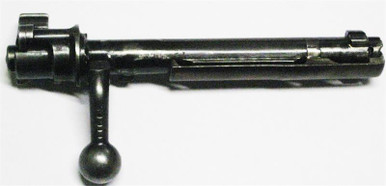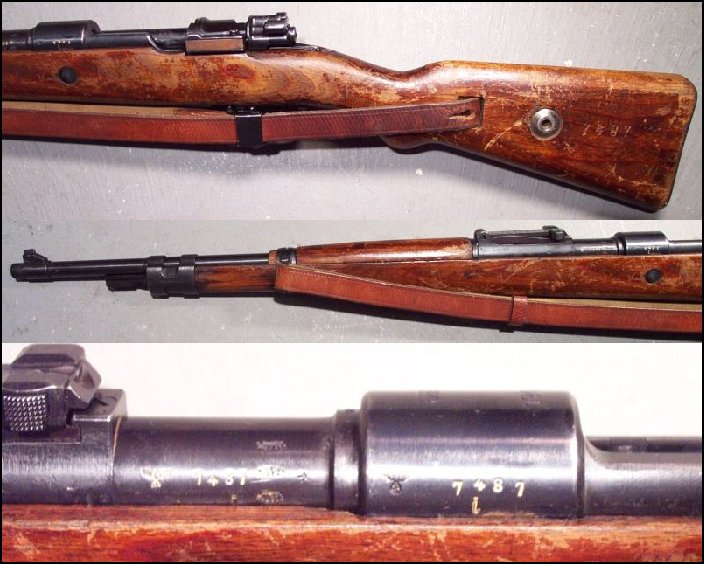The word 'Mauser' can refer either to the German weapons manufacturer, the Mauser-Werke Oberndorf Waffensysteme GmbH, or to the series of bolt-action rifles the Mauser-Werke manufacturered for the German armed forces. Mauser exported their design to several nations, so identification of the nationality of a Mauser rifle is important for collectors. Produced in large quantity by the Mauser Co., DWM, other commercial firms, and several German government arsenals, the Mauser 98 in various rifle and carbine versions was the standard German.
Back in World War II, the 8mm Mauser rifle was a staple for German soldiers, but now may be a useful tool for you to use.
Whether you are located in North America or Europe, the 8mm Mauser is a great tool for many things including the practical (and fun) purpose of hunting. Even though it is relatively unknown to North American hunters (or very rare at least), the rifle and the cartridge are powerful and effective for big game hunting.
Many hunters who appreciate deer hunting (or other big game) can benefit greatly from these rifles. This article will provide you a basic understanding of the rifle’s history, the specifications, and why it may be useful as a hunting rifle.
A Brief 8mm Mauser History
Based on the Patrone 88 cartridge which was a first generation smokeless powder cartridge, the 8mm Mauser (aka 7.92 x 57mm) was originally developed by the German Rifle Testing Commission in 1903 to 1905. It was created as a military service rifle cartridge for use in their Gewehr 98 bolt action rifles and was used by German soldiers in both WWI and WWII.
Due to the cartridge’s effectiveness and versatility, it was also adopted as a military service cartridge by many other countries such as the U.K., Spain and, even China. Although the cartridge has since been replaced by the 7.62 x 51mm NATO cartridge among NATO nations and by other military service cartridges in other countries, the 8mm Mauser cartridge is a favored hunting cartridge among European hunters even though some countries (such as France) prohibit civilians from using former military service cartridges.
1940 8mm German Mauser Value
Despite the fact that the Treaty of Versailles (pronounced “Versai”) which was signed by Germany at the conclusion WWI did allow the German Army to continue using the 7.92×57mm Mauser as their service rifle cartridge, it prevented civilians from using Mauser 98 rifles chambered for the cartridge for hunting or self defense.
During the 1930’s, Germany ceased to follow the restrictions imposed upon them by the Treaty of Versailles and the cartridge quickly gained popularity among civilians as a hunting cartridge and remains so to this day.
The 8mm Mauser and Current Manufacturing
The 7.92×57mm Mauser is now a commonly used hunting cartridge among European hunters along with other similar cartridges such as the 5.6×57mm, 6.5×55mm, 6.5×57mm, the 6.5×68mm and, the 8×68mm S magnum.
Today several well known European firearms manufacturers such as Zastava Arms, Blaser, Ceska Zbrojovka Firearms, Heym, Mauser Jagdweffen GmbH, and Styer Mannlicher produce modern bolt action hunting rifles chambered for the 7.92×57mm Mauser and European ammunition manufacturers such as Blaser, RUAG Ammotec/RWS, Prvi Partizan, Sako and, Sellier & Bellot produce factory loaded ammunition for them.

For reasons unknown, Americans seem to have an unfounded aversion to any cartridge that bears a Metric designation and thus, despite American hunters love affair with any cartridge that fires a .30 caliber bullet as is evidenced by the popularity of such cartridges as the .30-30 Winchester, the .308 Winchester, the .30-06 Springfield and, the .300 Winchester Magnum, the 8mm Mauser cartridge is relatively unknown to American hunters.
8mm Mauser Benefits

The slightly larger bullet diameter makes the 8mm Mauser potentially more deadly than cartridges that fire smaller diameter .30 caliber bullets. The wide range of factory loaded ammunition enables hunters to choose rounds that nearly duplicate the muzzle velocity and downrange ballistic of popular hunting cartridges (such as the .30-30 Winchester, the .308 Winchester and, the .30-06 Springfield).
Here are some quick examples:
- The standard .30-30 Winchester 170 grain load with a muzzle velocity of 2,200 fps is roughly equivalent to the standard 8mm Mauser 170 grain load with a muzzle velocity of 2,360 fps
- The standard .308 Winchester 150 grain load with a muzzle velocity of 2,820 fps is roughly equivalent to the 8mm Mauser 150 grain load with a muzzle velocity of 2,820 fps (Stars & Stripes)
- The standard .308 Winchester 180 grain load with a muzzle velocity of 2,620 fps is roughly equivalent to the 8mm Mauser 196 grain load with a muzzle velocity of 2,592 fps (Sellier & Bellot)
- The standard .30-06 Springfield 180 grain load with a muzzle velocity of 2,700 fps (Federal Premium, Barnes-X) is roughly equivalent to the 8mm Mauser 180 grain load with a muzzle velocity of 2,782 fps (Stars & Stripes, Barnes-X)
Hunting With The 8mm Mauser
The 8mm Mauser is an excellent choice for hunting medium sized game species such as the whitetail deer, Blacktail Deer, Mule Deer, Wild Boar and Feral Hogs, Big Horn Sheep, Mountain Goats, Antelope and, Black Bear. Our APEX conscious hunting retreat partners recommend the rifle there.

By combining heavy bullet weights with careful shot placement, it is even suitable for use on large game species such as Elk, Moose, Buffalo, and Musk Ox due the heavier weight bullet’s high sectional density which provides deep penetration.
There is one major problem: finding an American-made rifle chambered for the 8mm Mauser can be a bit challenging due its lack of popularity among American hunters.

Remington Arms did manufacture a limited edition Model 700 Classic bolt action rifle chambered for this cartridge in 2004 and rifles chambered to fire this cartridge are readily available from many European firearms manufacturers.
Both vintage military and sporterized versions of the Mauser Model 1898 bolt action rifle are still readily available on the used gun market but, it should be noted that older versions of these rifles are designed to fire a .318 caliber bullet and these rifles are designated as having “J” bores whereas, newer versions of these rifles are designed to fire a .323 caliber bullet and these rifles are designated as having “S” bores.
American-made 8mm Mauser ammunition is commonly loaded with .323 caliber bullets but, is designed to generate significantly lower chamber pressures than standard European loads so that the .323 caliber bullets can be safely fired in older .318 diameter J bores without generating excessive chamber pressures.
Doing so does limit the ammunition’s performance due to a lower muzzle velocity.
Modern, full-powered, European manufacture 8mm Mauser ammunition should never be fired in vintage Mauser Model 1898 rifles unless you are certain that the rifle has the .323 S bore diameter.
The 8mm Mauser Takes Hunting to the Next Level

8mm K98 Mauser For Sale
The 8mm Mauser is a relatively unknown cartridge among American hunters, but its wide range of bullet weights and muzzle velocities make it an excellent choice for hunting medium to large North American, European, and even some African game species.
German 8mm Mauser Markings
The 8mm Mauser’s larger bullet diameter combined with its high sectional density make it a potentially more deadly cartridge than the venerable .30-06 Springfield cartridge. This makes it a popular hunting cartridge among European hunters. Most importantly, this fact makes the 8mm Mauser an excellent choice for North Americans who desire to hunt with a bit of novelty.
NOTE: My partner is an Austin doula (birth coach) and suggests women who are pregnant forego using the 8 mm mauser as it is a powerful rifle. The percussion and force created can disrupt the child’s health.
